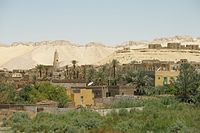
Photo from wikipedia
Abstract Today, Bir Tarfawi, Kharga and Dakhleh Oases all sit in Egypt's hyperarid Western Desert. A dearth of naturally occurring surface water coupled with ≤ 0.1 mm/y of precipitation, and evaporation rates… Click to show full abstract
Abstract Today, Bir Tarfawi, Kharga and Dakhleh Oases all sit in Egypt's hyperarid Western Desert. A dearth of naturally occurring surface water coupled with ≤ 0.1 mm/y of precipitation, and evaporation rates > 2 m/y make Bir Tarfawi uninhabitable today, while Dakhleh and Kharga depend on borehole water to support human inhabitation. Yet in scattered locations dotting the Quaternary surfaces and deposits near each oasis, Paleolithic artefacts, fossil ungulate teeth, and snails record times when surface water did exist in wetlands, small ponds, and even large lakes. At Bir Tarfawi in Marine Isotope Stages (MIS) 5, 7, and 13, wetlands or small lakes supported freshwater snails, large herbivores, and hominins. Dakhleh Oasis hosted a large lake in MIS 6 that provided a deep reliable water supply for many millennia subsequently. ESR dates on fossils and tufa dates show thriving lacustrine and terrestrial ecosystems at Dakhleh during MIS 5, 7, 9, 11, and 17, and in shorter episodes in MIS 1, 2, 3, 6, and 12. At Kharga Oasis, springs discharged along the Libyan Escarpment edge, but the water was ponded in small basins dammed within tufa deposits. These dated deposits and fossils attest that water existed there in MIS 2–11, and one spot dating to ∼ 2.3 Ma. This proxy evidence suggest that, thanks to higher rainfall and/or groundwater tables, sufficient water persisted for much of the Pleistocene, supporting food resources, like large herbivores and molluscs, to thrive and enabling hominin habitation. and activity in the Western Desert.
Journal Title: Journal of African Earth Sciences
Year Published: 2017
Link to full text (if available)
Share on Social Media: Sign Up to like & get
recommendations!